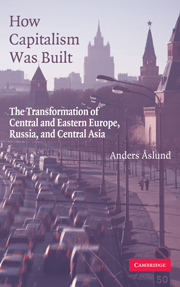Book contents
- Frontmatter
- Contents
- List of Tables and Figures
- List of Abbreviations
- Acknowledgments
- Introduction: A World Transformed
- 1 Communism and Its Demise
- 2 Shock Therapy versus Gradualism
- 3 Output: Slump and Recovery
- 4 Liberalization: The Creation of a Market Economy
- 5 From Hyperinflation to Financial Stability
- 6 Privatization: The Establishment of Private Property Rights
- 7 An Inefficient Social System
- 8 Democracy versus Authoritarianism
- 9 From Crime toward Law
- 10 The Role of Oligarchs
- 11 The Impact of the Outside World
- Conclusions: A World Transformed
- Bibliography
- Index
6 - Privatization: The Establishment of Private Property Rights
Published online by Cambridge University Press: 05 September 2012
- Frontmatter
- Contents
- List of Tables and Figures
- List of Abbreviations
- Acknowledgments
- Introduction: A World Transformed
- 1 Communism and Its Demise
- 2 Shock Therapy versus Gradualism
- 3 Output: Slump and Recovery
- 4 Liberalization: The Creation of a Market Economy
- 5 From Hyperinflation to Financial Stability
- 6 Privatization: The Establishment of Private Property Rights
- 7 An Inefficient Social System
- 8 Democracy versus Authoritarianism
- 9 From Crime toward Law
- 10 The Role of Oligarchs
- 11 The Impact of the Outside World
- Conclusions: A World Transformed
- Bibliography
- Index
Summary
The postcommunist privatization was unprecedented. In one incredible decade, more than 150,000 large and medium-size enterprises, hundreds of thousands of small firms, and millions of apartments and houses have been privatized (Djankov and Murrell 2002). The private sector went from being nearly nonexistent to producing almost two-thirds of GDP. This was the most fundamental change brought about by the transition.
Strange as it may sound today, the privatization of public enterprises was a novelty that was introduced by British Prime Minister Margaret Thatcher after her election in 1979, and President Augusto Pinochet in Chile at about the same time. The United States did not start advocating privatization abroad until 1985 (Williamson 1990), and the now abundant privatization literature started in 1987.
Nothing aroused more passion than privatization. It involved every/thing – politics, law, justice, morals, and economics. It was the fundamental dividing line between a socialist and a capitalist society. No obvious precedent existed for such a profound transformation. Thatcher had leisurely privatized less than a dozen enterprises a year. Such a pace would have condemned the postcommunist countries to socialism for many years to come. This need for novel approaches contradicted one of the radical reformers' battle cries, “no more experiments.” Privatization also provoked emotions because it was so concrete and visible. All people wanted their own piece of property for living or work (“I want to own my house!”). This concreteness confused people about the value of enterprises.
- Type
- Chapter
- Information
- How Capitalism Was BuiltThe Transformation of Central and Eastern Europe, Russia, and Central Asia, pp. 143 - 181Publisher: Cambridge University PressPrint publication year: 2007



